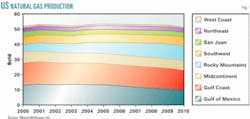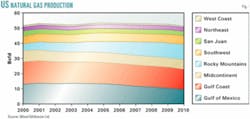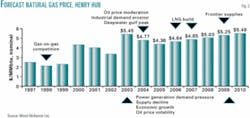Industry panel warns of possible US gas supply crisis
The future near and midterm supply of US and Canadian natural gas came under close scrutiny during a panel discussion by industry participants Feb. 20 at the second annual Energy Finance Conference. The conference was hosted jointly by the Center for Energy Finance Education & Research and ConocoPhillips at the University of Texas at Austin.
One panel member forecast a "flat" gas production outlook for US and Canada over the next decade, while another contended that the US in particular is heading toward a critical point in the next 5-10 years with regard its supply-demand balance.
Also, the effects of gas supply and demand on near and midterm gas prices in the US were a hot topic among panel members. Several noted that, given the ongoing constraints placed on US gas supplies, it is likely gas prices will sustain their current strong levels and will remain highly volatile over the next few years.
The panelists each ticked off reasons for the tightness in gas supply, especially in the US. These included the lack of significant gas discoveries, the steady increase of electric power demand, and the lagging development efforts for LNG gas import capacity.
Gas supply fears 'unfounded'
"The worst fears concerning [US gas] supply are unfounded," asserted Ed Kelly, head of North American gas and power consulting for Wood Mackenzie Global Consultants, part of Edinburgh-based Wood Mackenzie Ltd. While gas supplies in the US are "set to decline," he said, unconventional supply development and high prices will keep these declines in check. Gas production from sources such as shale gas and coalbed methane can increase, thus offsetting declines in mature basins in the US, Kelly said.
In the US, Kelly said, "Our view is that [gas] supply is not growing and cannot grow beyond 2005, even with a very healthy price outlook, but nor does it fall off a cliff."
The challenge of maintaining gas supply in the US will "intensify beyond 2006" as deepwater Gulf of Mexico production begins to decline, he said, especially without the existence of any clear prospects in the gulf that would offset production declines there.
In the near term, Kelly explained, growth in the deepwater will offset rapid declines in the gulf's Outer Continental Shelf. Beyond 2005, however, deepwater volumes will plateau, and gulf declines will accelerate. "Positive results in the eastern deepwater gulf could help extend production growth in the deepwater through 2006," he suggested.
LNG, Alaskan gas supplies
And while LNG import volumes into the US are expected eventually to "surge," in the near to midterm, it is unlikely they will "flood the market," Kelly said.
By 2005, he said, summer LNG deliveries will be constrained by available regasification capacity. "The first greenfield US LNG regasification facilities are expected to come online in 2007—one Gulf Coast facility and one Baja [California] facility should begin importing LNG that year."
LNG regasification capacity and liquefaction capacity will grow in step, Kelly noted, with capacity increasing to 6.2 bcfd of gas in 2010.
Kelly added that, until an Alaskan natural gas pipeline project comes online, gas demand would be constrained by available supply. Alaskan supplies could still reach the North American gas grid in 2013, he said, but "that date is now slipping," and delays could push in-service back years.
Canadian supplies
Canada, meanwhile, is going through "a similar transition," as in the US with regard to gas supply. In Canada, Kelly said, "Higher-cost plays will help support [gas] production until arctic supplies come online."
Kelly forecast that, following a rebound in Canadian gas production during 2004-05, production would flatten, as increased activity would suffice only to offset declines in existing production.
During 2004-10, Kelly estimated that, Canadian gas supplies, largely buoyed by production in Western Canada, would maintain levels at 17-18 bcfd.
Pipeline industry view
Greg Rizzo, executive vice-president, pipelines, for Duke Energy Corp., said that, after more than a decade of relatively low gas prices in the US, gas prices are now more volatile at a much higher level.
An increase in gas prices, Rizzo said, will lead to "demand destruction" from heavy and alternative users of the fuel, thus leading to eventual lower prices. Then, "as gas prices fall, these swing-users will increase demand for natural gas leading to higher prices," he added.
Rizzo concluded, "Deregulation has lead to the commoditization of natural gas prices, which has shifted contracting from long term to short term. As long as we have short-term pricing, the market volatility will continue.
"High-price trends will be followed by low-price trends, especially as huge basins such as Alaska come on stream," he said.
Forecast gas crisis
One panelist viewed the shortfall in natural gas supplies in the US as "massive." In terms of British thermal units, Andy Weissman, founder and chairman of Energy Ventures Group, said that, by 2010, this shortfall would equal, in oil terms, about 1.5 times the level of oil imports from Saudi Arabia, currently about 1.8 million b/d.
This shortfall, Weissman explained, will be the results of the combined impact of the rapid rise in gas demand by the electric power sector and the rapid aging of most major fields in the US and Canada—"and the inability to significantly expand supplies any time this decade."
And this shortfall, he noted, is not just a short-term problem. "Recent winter price spikes and the California crisis in 2000 are early warning signs of a much deeper crisis to come," Weissman said. In fact, the gap between projected US gas demand and the available supplies likely will increase "every year for at least the next 5-7 years," he forecast.
Focusing attention on the imminent gas supply problem, Weissman claimed, will be "the most important challenge facing energy providers and the US economy as a whole for most of the decade."
Regarding gas price forecasting, Weissman stated that, most existing price forecasts are no longer reliable, for either electric power or natural gas. Gas price volatility, which has always been high, will become even greater in the near to midterm, he said.
On average, Weissman contended, natural gas prices likely will average at least $8-10/MMbtu, and could potentially reach much higher.
These price fluctuations will have "profound implications" for US economy, he warned, particularly for the competitiveness of the US gas industry and the overall health of the US economy for much of the next decade.
There is an "urgent need" to take steps to reduce the pressures that are about to develop in the natural gas market, Weissman concluded. Otherwise, there is "no way" the current projected need for gas in the US during the rest of the decade can be met.


